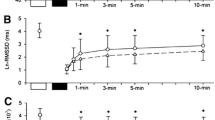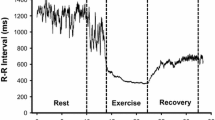Abstract
The aim of the present study was to investigate the effect of cold water face immersion on post-exercise parasympathetic reactivation, inferred from heart rate (HR) recovery (HRR) and HR variability (HRV) indices. Thirteen men performed, on two different occasions, an intermittent exercise (i.e., an all-out 30-s Wingate test followed by a 5-min run at 45% of the speed reached at the end of the 30–15 Intermittent Fitness test, interspersed with 5 min of seated recovery), randomly followed by 5 min of passive (seated) recovery with either cold water face immersion (CWFI) or control (CON). HR was recorded beat-to-beat and vagal-related HRV indices (i.e., natural logarithm of the high-frequency band, LnHF, and natural logarithm of the square root of the mean sum of squared differences between adjacent normal R–R intervals, Ln rMSSD) and HRR (e.g., heart beats recovered in the first minute after exercise cessation) were calculated for both recovery conditions. Parasympathetic reactivation was faster for the CWFI condition, as indicated by higher LnHF (P = 0.004), Ln rMSSD (P = 0.026) and HRR (P = 0.002) values for the CWFI compared with the CON condition. Cold water face immersion appears to be a simple and efficient means of immediately accelerating post-exercise parasympathetic reactivation.



Similar content being viewed by others
References
Batterham AM, Hopkins WG (2006) Making meaningful inferences about magnitudes. Int J Sports Physiol Perform 1:50–57
Billman GE (2002) Aerobic exercise conditioning: a nonpharmacological antiarrhythmic intervention. J Appl Physiol 92:446–454
Billman GE (2006) Heart rate response to onset of exercise: evidence for enhanced cardiac sympathetic activity in animals susceptible to ventricular fibrillation. Am J Physiol Heart Circ Physiol 291:H429–H435
Blain G, Meste O, Bermon S (2005) Influences of breathing patterns on respiratory sinus arrhythmia in humans during exercise. Am J Physiol Heart Circ Physiol 288:H887–H895
Buchheit M, Gindre C (2006) Cardiac parasympathetic regulation: respective associations with cardiorespiratory fitness and training load. Am J Physiol Heart Circ Physiol 291:H451–H458
Buchheit M, Laursen PB (2009) Treatment of hyperthermia: is assessment of cooling efficiency enough? Exp Physiol 94:627–629
Buchheit M, Papelier Y, Laursen PB, Ahmaidi S (2007a) Noninvasive assessment of cardiac parasympathetic function: post-exercise heart rate recovery or heart rate variability? Am J Physiol Heart Circ Physiol 23:H8–H10
Buchheit M, Laursen PB, Ahmaidi S (2007b) Parasympathetic reactivation after repeated sprint exercise. Am J Physiol Heart Circ Physiol 293:H133–H141
Buchheit M, Al Haddad H, Millet GP, Lepretre PM, Newton M, Ahmaidi S (2009a) Cardiorespiratory and cardiac autonomic responses to 30–15 intermittent fitness test in team sport players. J Strength Cond Res 23:93–100
Buchheit M, Peiffer JJ, Abbiss CR, Laursen PB (2009b) Effect of cold water immersion on postexercise parasympathetic reactivation. Am J Physiol Heart Circ Physiol 296:H421–H427
Buchheit M, Al Haddad H, Laursen PB, Ahmaidi S (2009c) Effect of body posture on postexercise parasympathetic reactivation in men. Exp Physiol 94:795–804
Cohen J (1988) Statistical power analysis for the behavioral sciences. Lawrence Erlbaum, Hillsdale
Cole CR, Blackstone EH, Pashkow FJ, Snader CE, Lauer MS (1999) Heart-rate recovery immediately after exercise as a predictor of mortality. N Engl J Med 341:1351–1357
Dewland TA, Androne AS, Lee FA, Lampert RJ, Katz SD (2007) Effect of acetylcholinesterase inhibition with pyridostigmine on cardiac parasympathetic function in sedentary adults and trained athletes. Am J Physiol Heart Circ Physiol 293:H86–H92
Eckberg DL (2003) The human respiratory gate. J Physiol 548:339–352
Eckberg DL, Mohanty SK, Raczkowska M (1984) Trigeminal-baroreceptor reflex interactions modulate human cardiac vagal efferent activity. J Physiol 347:75–83
Finley JP, Bonet JF, Waxman MB (1979) Autonomic pathways responsible for bradycardia on facial immersion. J Appl Physiol 47:1218–1222
Goldberger JJ, Challapalli S, Tung R, Parker MA, Kadish AH (2001) Relationship of heart rate variability to parasympathetic effect. Circulation 103:1977–1983
Goldberger JJ, Le FK, Lahiri M, Kannankeril PJ, Ng J, Kadish AH (2006) Assessment of parasympathetic reactivation after exercise. Am J Physiol Heart Circ Physiol 290:H2446–H2452
Gorman AJ, Proppe DW (1982) Influence of heat stress on arterial baroreflex control of heart rate in the baboon. Circ Res 51:73–82
Goulopoulou S, Heffernan KS, Fernhall B, Yates G, Baxter-Jones AD, Unnithan VB (2006) Heart rate variability during recovery from a Wingate test in adolescent males. Med Sci Sports Exerc 38:875–881
Hayashi N, Ishihara M, Tanaka A, Osumi T, Yoshida T (1997) Face immersion increases vagal activity as assessed by heart rate variability. Eur J Appl Physiol Occup Physiol 76:394–399
Hedman AE, Hartikainen JE, Tahvanainen KU, Hakumaki MO (1995) The high frequency component of heart rate variability reflects cardiac parasympathetic modulation rather than parasympathetic ‘tone’. Acta Physiol Scand 155:267–273
Hopkins WG (2007) A spreadsheet for deriving a confidence interval, mechanistic inference and clinical inference from a p value. Sportscience 11:16–20
Hopkins WG, Marshall SW, Batterham AM, Hanin J (2009) Progressive statistics for studies in sports medicine and exercise science. Med Sci Sports Exerc 41:3–13
Imai K, Sato H, Hori M, Kusuoka H, Ozaki H, Yokoyama H, Takeda H, Inoue M, Kamada T (1994) Vagally mediated heart rate recovery after exercise is accelerated in athletes but blunted in patients with chronic heart failure. J Am Coll Cardiol 24:1529–1535
Inbar O, Bar-Or O, Skinner JS (1996) The Wingate anaerobic test. Human Kinetics, Champaign, IL
Khurana RK (2007) Cold face test: adrenergic phase. Clin Auton Res 17:211–216
Khurana RK, Wu R (2006) The cold face test: a non-baroreflex mediated test of cardiac vagal function. Clin Auton Res 16:202–207
Kinoshita T, Nagata S, Baba R, Kohmoto T, Iwagaki S (2006) Cold-water face immersion per se elicits cardiac parasympathetic activity. Circ J 70:773–776
LeBlanc J, Blais B, Barabe B, Cote J (1976) Effects of temperature and wind on facial temperature, heart rate, and sensation. J Appl Physiol 40:127–131
Levy MN (1971) Sympathetic–parasympathetic interactions in the heart. Circ Res 29:437–445
Miyamoto T, Kawada T, Takaki H, Inagaki M, Yanagiya Y, Jin Y, Sugimachi M, Sunagawa K (2003) High plasma norepinephrine attenuates the dynamic heart rate response to vagal stimulation. Am J Physiol Heart Circ Physiol 284:H2412–H2418
Miyamoto T, Oshima Y, Ikuta K, Kinoshita H (2006) The heart rate increase at the onset of high-work intensity exercise is accelerated by central blood volume loading. Eur J Appl Physiol 96:86–96
Mourot L, Bouhaddi M, Gandelin E, Cappelle S, Dumoulin G, Wolf JP, Rouillon JD, Regnard J (2008) Cardiovascular autonomic control during short-term thermoneutral and cool head-out immersion. Aviat Space Environ Med 79:14–20
Nunan D, Donovan G, Jakovljevic DG, Hodges LD, Sandercock GR, Brodie DA (2009) Validity and reliability of short-term heart-rate variability from the Polar S810. Med Sci Sports Exerc 41:243–250
Paulev PE, Pokorski M, Honda Y, Ahn B, Masuda A, Kobayashi T, Nishibayashi Y, Sakakibara Y, Tanaka M, Nakamura W (1990) Facial cold receptors and the survival reflex “diving bradycardia” in man. Jpn J Physiol 40:701–712
Popadic Gacesa JZ, Barak OF, Grujic NG (2009) Maximal anaerobic power test in athletes of different sport disciplines. J Strength Cond Res 23:751–755
Pretorius T, Bristow GK, Steinman AM, Giesbrecht GG (2006) Thermal effects of whole head submersion in cold water on nonshivering humans. J Appl Physiol 101:669–675
Savin WM, Davidson DM, Haskell WL (1982) Autonomic contribution to heart rate recovery from exercise in humans. J Appl Physiol 53:1572–1575
Smith JC, Stephens DP, Winchester PK, Williamson JW (1997) Facial cooling-induced bradycardia: attenuating effect of central command at exercise onset. Med Sci Sports Exerc 29:320–325
Smith LL, Kukielka M, Billman GE (2005) Heart rate recovery after exercise: a predictor of ventricular fibrillation susceptibility after myocardial infarction. Am J Physiol Heart Circ Physiol 288:H1763–H1769
Task Force of the European Society of Cardiology and the North American Society of Pacing and Electrophysiology (1996) Heart rate variability, standards of measurement, physiological interpretation, and clinical use. Circulation 93:1043–1065
Tipton MJ (1989) The initial responses to cold-water immersion in man. Clin Sci (Lond) 77:581–588
Tulppo MP, Makikallio TH, Seppanen T, Airaksinen JK, Huikuri HV (1998) Heart rate dynamics during accentuated sympathovagal interaction. Am J Physiol 274:H810–H816
Acknowledgments
The authors thank Bachar Haidar for his helpful assistance with data collection and the participants for their enthusiastic collaboration.
Author information
Authors and Affiliations
Corresponding author
Additional information
Communicated by Dag Linnarsson.
Rights and permissions
About this article
Cite this article
Al Haddad, H., Laursen, P.B., Ahmaidi, S. et al. Influence of cold water face immersion on post-exercise parasympathetic reactivation. Eur J Appl Physiol 108, 599–606 (2010). https://doi.org/10.1007/s00421-009-1253-9
Accepted:
Published:
Issue Date:
DOI: https://doi.org/10.1007/s00421-009-1253-9




